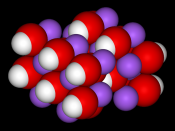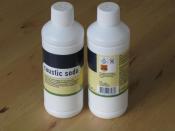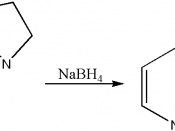Lab 12: Reduction of an Aldehyde to a Primary Alcohol by Use of NaBH4Purpose(i)To select an appropriate solvent system.
(ii)To synthesize alcohol from aldehyde by NaBH4 reduction.
(iii)To identify the aldehyde isomer based on the melting point of the alcohol produced.
Procedure(Please refer to the detailed instructions on lab 12 handout)Physical Quantity TableType of substanceMolecular FormulaMolecular Weight (g/mol)Density(g/cm3)Melting Point(oC)Boiling Point(oC)HazardO-vanillinC8H8O3152.15-42.5265-266Harmful andIrritantFor all 3vanillinC8H8O3152.151.05680-81285isovanillinC8H8O3152.15-113-115179Vanillyl alcohol*C8H10O3154.17-113-115--Sodium hydroxide**NaOH39.992.13181390CorrosiveHydrochloric acidHCl36.461.18-26110CorrosiveSodium borohydrideNaBH437.831.074505400IrritantCorrosive*Vanillyl alcohol is soluble in cold organic solvents such as ether/alcohol and hot water, but insoluble in cold water.
**Caution: Should not touch NaBH4 directly with skin.
Result and CalculationMass of aldehyde #1 (starting material) = 0.3999 gMass of alcohol #1 (product) = 0.1573 g alcoholTheoretical yield = 0.3999 g vanillin x (154.17 g alcohol/152.15 g vanillin) = 0.4052gPercentage yield = (actual yield/theoretical yield) x 100%= 0.1573 g alcohol/ 0.4052 g alcohol = 38.8%Solvent system chosen = ethyl acetate and hexane in 9:1 ratioMelting point range of alcohol #1 = 108oC -109oCObservationWhen the NaOH was added to the aldehyde #1, the solution turned yellowish green.
It took 10 minutes for the white solid NaBH4 to completely dissolve in the aldehyde solution. When the HCl was added, the solution fizzed and bubbles came off. White precipitate formed. After the vacuum filtration, shiny white crystalline solid was found.
DiscussionFrom the melting point range of the alcohol 108oC -109oC, it could be determined that the aldehyde isomer used should be vanillin, since vanillin produces vanillyl alcohol that has the melting point range of 113 oC -115oC which is quite close to the experimental melting point range. The slight depression could be due to the impurities present in the solid such as water.
In this experiment, the vanillin is converted into vanillyl alcohol by formation of alkoxide ion, followed by protonation. The detailed...


